Archilife Delegation for SB2002 International Conference(2) (Part: 3)
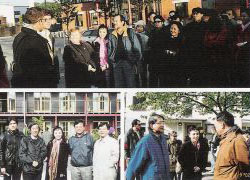 9月27日一早,團員們不畏凜冽的寒風,紛紛到Quality Hotel旁的碼頭飽覽風光。經過解說員的說明後,大家才知道這所旅館是由船塢改建而成,其中還加添後現代手法的室內設計。在這裡的天氣感覺上比起挪威還冷得多,連港口旁的木製地板上都覆有薄冰,也讓我們這群來自熱帶國度的過客們不由自主地搓起手來取暖。 9月27日一早,團員們不畏凜冽的寒風,紛紛到Quality Hotel旁的碼頭飽覽風光。經過解說員的說明後,大家才知道這所旅館是由船塢改建而成,其中還加添後現代手法的室內設計。在這裡的天氣感覺上比起挪威還冷得多,連港口旁的木製地板上都覆有薄冰,也讓我們這群來自熱帶國度的過客們不由自主地搓起手來取暖。In early morning on September 27, showing no fear of the chilly wind, we went sightseeing at the pier next to the Quality Hotel. After the explanation of the escort, we finally found out that the hotel was built from a dock with some postmodernist interior design. We felt it was colder than in Norway, and there was thin frost on the wooden floor near the harbor. From a subtropical country, we just could not help rubbing our hands to get warmer.  在短暫的巡覽後,考察團一行搭車來到哥德堡的新市區Norra Alvstranden進行參訪,隨後則轉往Gardsten接受由瑞典當地知名企業Skanska所安排的參觀行程。由於天氣寒冷,接待單位特別為參觀團員準備熱騰騰的咖啡怯寒。Gardsten主要是由Skanska公司出資所進行之老舊建築更新轉型為生態建築的案例,也是該企業回饋社會的具體作為。團員們按導覽一一參觀其內的設施,建築物旁設有玻璃溫室以保留熱,溫室中也種植許多作物,有不同品種的番茄、草莓與香草,而溫室連接到室內就有一台廚餘處理機,其內的食物殘渣,最後將做成堆肥提供溫室中的植物使用。 在短暫的巡覽後,考察團一行搭車來到哥德堡的新市區Norra Alvstranden進行參訪,隨後則轉往Gardsten接受由瑞典當地知名企業Skanska所安排的參觀行程。由於天氣寒冷,接待單位特別為參觀團員準備熱騰騰的咖啡怯寒。Gardsten主要是由Skanska公司出資所進行之老舊建築更新轉型為生態建築的案例,也是該企業回饋社會的具體作為。團員們按導覽一一參觀其內的設施,建築物旁設有玻璃溫室以保留熱,溫室中也種植許多作物,有不同品種的番茄、草莓與香草,而溫室連接到室內就有一台廚餘處理機,其內的食物殘渣,最後將做成堆肥提供溫室中的植物使用。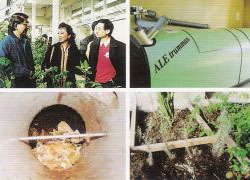 After a short tour, we took bus to visit Norra Alvstranden in Gothenburg. Later on, we turned to Gardsten for the tour arranged by the famous Swedish business, Skanska. As it was freezing out there, they prepared hot coffee for us. Gardsten was a green building renewed from an abandoned building funded by Skanska as feedback for society. With the tour map, we explored the facilities in Gardsten. There was a glass greenhouse next to the building to preserve heat. There were different plants grown, such as tomatoes, strawberries, and vanilla. There was a kitchen waste processing linking the greenhouse and indoor. Kitchen waste was turned into compost for use by plants inside the greenhouse. After a short tour, we took bus to visit Norra Alvstranden in Gothenburg. Later on, we turned to Gardsten for the tour arranged by the famous Swedish business, Skanska. As it was freezing out there, they prepared hot coffee for us. Gardsten was a green building renewed from an abandoned building funded by Skanska as feedback for society. With the tour map, we explored the facilities in Gardsten. There was a glass greenhouse next to the building to preserve heat. There were different plants grown, such as tomatoes, strawberries, and vanilla. There was a kitchen waste processing linking the greenhouse and indoor. Kitchen waste was turned into compost for use by plants inside the greenhouse.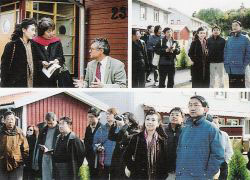 中午,團員們在生態屋旁的餐廳內享用由Skanska公司招待之午餐後,繼續風塵僕僕走訪位於Lindas的無耗能住宅(O-energy houses),實地考察當地生態建築運作的現況。接著考察團一行驅車前往車程三個多小時遠的Malmo,參觀當地著名的BoOl案例。本區原為工業區,經過都市再更新計畫的推動,使其重新披上嶄新的外衣,有了新的風貌。團員們徒步穿梭於街道中,在解說者的導引下,一一觀摩體驗當地住民如何力行低耗能,甚至是不耗能的生活,其中的曝氣水池、水生植物區與美麗的海岸等都讓大家留下了深刻的印象。 At noon, after enjoying lunch provided by Skanska in the restaurant of Gardsten, we continued our visit to the 0-energy houses in Lindas to observe the present operations of local eco-buildings. Then, we traveled to Malmo, about 3-hour ride, to visit the famous BoO1 case there. Malmo was an industrial area, and it put on a brand new coat after the urban renewal. While shuffling through the city, under the guidance of the escort, we observed how local inhabitants practiced the low-energy and even 0-energy life. The aeration pond, aqua plant area and beautiful shore there impressed us a lot. 中午,團員們在生態屋旁的餐廳內享用由Skanska公司招待之午餐後,繼續風塵僕僕走訪位於Lindas的無耗能住宅(O-energy houses),實地考察當地生態建築運作的現況。接著考察團一行驅車前往車程三個多小時遠的Malmo,參觀當地著名的BoOl案例。本區原為工業區,經過都市再更新計畫的推動,使其重新披上嶄新的外衣,有了新的風貌。團員們徒步穿梭於街道中,在解說者的導引下,一一觀摩體驗當地住民如何力行低耗能,甚至是不耗能的生活,其中的曝氣水池、水生植物區與美麗的海岸等都讓大家留下了深刻的印象。 At noon, after enjoying lunch provided by Skanska in the restaurant of Gardsten, we continued our visit to the 0-energy houses in Lindas to observe the present operations of local eco-buildings. Then, we traveled to Malmo, about 3-hour ride, to visit the famous BoO1 case there. Malmo was an industrial area, and it put on a brand new coat after the urban renewal. While shuffling through the city, under the guidance of the escort, we observed how local inhabitants practiced the low-energy and even 0-energy life. The aeration pond, aqua plant area and beautiful shore there impressed us a lot.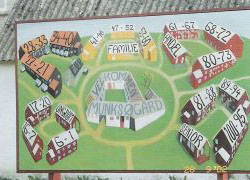 晚上,團員們在Malmo用過道地的瑞典晚餐後,隨即轉往本次參訪行程的最後一站:丹麥首都哥本哈根。在此次參觀行程中,來自大陸的參加人員也時時隨侍在側,讓團員們有機會領教到來自對岸的威脅與虎視耽耽,所幸團長等人因應得宜,才使祐生此行圓滿達成任務。 晚上,團員們在Malmo用過道地的瑞典晚餐後,隨即轉往本次參訪行程的最後一站:丹麥首都哥本哈根。在此次參觀行程中,來自大陸的參加人員也時時隨侍在側,讓團員們有機會領教到來自對岸的威脅與虎視耽耽,所幸團長等人因應得宜,才使祐生此行圓滿達成任務。In the evening, we had an authentic Swedish dinner in Malmo. Then, we headed to the last stop of our trip: Copenhagen, capital of Denmark. On our trip, participants from Mainland China were walking side by side all the way, and we just felt the threats and the scrutiny from the opposite side of the Taiwan Straits. Fortunately, we could accomplish the mission smoothly with the skilful maneuvering of Secretary General Huang Chin-ying and others. 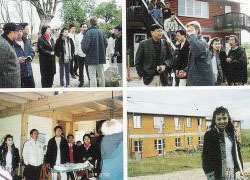 9月28日一早,考察團員按原訂計畫前往參觀幼稚園kindergarten Stenurten及位於Mlinkesogard的100 ecologicail houses,因為司機對路程不熟悉,耽擱了許多寶貴的時間,為了不延誤考察團回國的行程,團長於是當機立斷取消Kindergarten Stenurten行程,直接前往Munkesogard參觀lOO ecological houses。在這座生態村內規劃有不同的區塊與建築,分別居住著不同年齡層的住民,他們過著類似人民公社般的共同生活。比較難得的是這座村落是由一群有共同理念的人民自發性地營居,設有自己循環的堆肥與畜牧系統,並且共同分享所有的勞務,他們的運作經驗有不少更值得做為未來推展共生生活之借鏡。 9月28日一早,考察團員按原訂計畫前往參觀幼稚園kindergarten Stenurten及位於Mlinkesogard的100 ecologicail houses,因為司機對路程不熟悉,耽擱了許多寶貴的時間,為了不延誤考察團回國的行程,團長於是當機立斷取消Kindergarten Stenurten行程,直接前往Munkesogard參觀lOO ecological houses。在這座生態村內規劃有不同的區塊與建築,分別居住著不同年齡層的住民,他們過著類似人民公社般的共同生活。比較難得的是這座村落是由一群有共同理念的人民自發性地營居,設有自己循環的堆肥與畜牧系統,並且共同分享所有的勞務,他們的運作經驗有不少更值得做為未來推展共生生活之借鏡。In the early morning on September 28, we visited Kindergarten Stenurten and 100 ecological houses in Mlinkesogard as planned. We wasted some precious time because the driver was unfamiliar with the way to get there. Secretary General Huang Chin-ying immediately decided to skip the Kindergarten Stenurten and directly visit the 100 ecological houses in Munkesogard to ensure that the homecoming schedule was not delayed. In this ecological community, there were different zones and buildings for inhabitants of different ages living in a lifestyle like that of a commune. It was rather precious that the community was voluntarily run by a group of people sharing the same way of thinking. They had their own compost and animal rearing systems and shared all labor services. Their way of operations is valuable for promoting the commune life in the future. |

